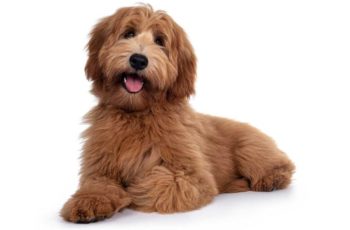This post may contain affiliate links. We may earn money or products from the companies mentioned in this post.
Removing tear stains on dogs is a common concern for pet owners, especially those with light-colored or white-coated breeds.
Tear stains are those brown or reddish-brown streaks that often appear under a dog’s eyes.
Below, you can clearly see them on one of my former pet sitting clients, Husky Haley.
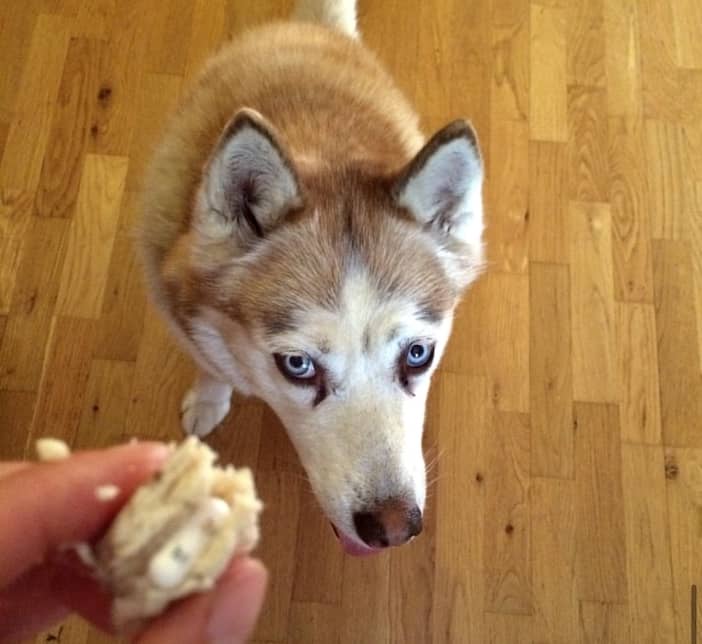
Haley wasn’t the only client pup who had tear stains, there were a few others too.
For example, Bichon Frisés Ralphie and Tori, and Goldendoodle Lulu.
Thankfully, they were all successful in removing the tear stains on their dogs’ faces.
So in this blog post, I’ll share several approaches that helped!
What Causes Dog Tear Stains?
Let’s start by looking at what causes dog tear stains in the first place.
After all, it’s always easier to solve a problem when we understand its underlying reasons, right?
Now, dog tear stains are caused by a combination of factors, such as:
- Porphyrins in tears
- Shallow tear ducts
- Tear production
- Certain foods
- Facial folds
- Infections
- Allergies
Porphyrins
Porphyrins are naturally occurring compounds found in tears, saliva, and other body fluids.
When tears come into contact with dog fur, particularly light-colored fur, the porphyrins can react with light and oxidize.
This results in a reddish-brown to dark-brown discoloration.
Shallow Dog Tear Ducts
Some dog breeds, especially those with brachycephalic (flat-faced) features, tend to have shallow tear ducts that do not efficiently drain tears away from the eyes.
This can result in tear overflow and staining.
Dog Tear Production
You probably know that tears keep the eyes lubricated and free from debris.
However, some dogs produce more tears than others.
Unfortunately, excessive tear production can overwhelm the drainage system, which leads to an overflow of tears onto the fur around the eyes.
Dietary Factors
Some dog foods with artificial colorings, preservatives, or allergenic triggers can increase tear staining in dogs who are sensitive to those ingredients.
Facial Anatomy
Dogs with prominent eyes, loose facial skin, or facial folds tend to be more susceptible to tear staining.
That’s because the shape of their faces can cause tears to pool and remain in the fur around the eyes, which promotes staining.
Infections or Dog Allergies
Eye infections or environmental allergies can lead to increased tear production in dogs and, in turn, contribute to tear staining.
Irritants and Tear Duct Blockages
Foreign substances, irritants, or blocked tear ducts can disrupt the normal tear drainage process and lead to tear staining.
Which Dog Breeds Are Known To Have Tear Stains?
All that said, the following dog breeds are known to be prone to tear stains:
Maltese and Shih Tzus are known for their long coats, which make tear stains more noticeable. The long, flowing hair around their eyes can trap tears and lead to tear staining.
Pugs, English Bulldogs, Pekingese and Chihuahuas have flat faces (brachycephalic), which can also affect tear drainage.
Poodles, Bichons and Cocker Spaniels, especially those with light-colored coats, can also develop tear stains due to their tear production and curly coat around the eyes.
For English Bulldogs, it’s their facial folds that can contribute to tear staining because they collect moisture.
Natural Way To Remove Tear Stains On Dogs
Coming up, I’ll share a few easy approaches that helped in for several of my clients.
Pictured below are two of my Bichon dog walking clients, Ralphie & Tori:
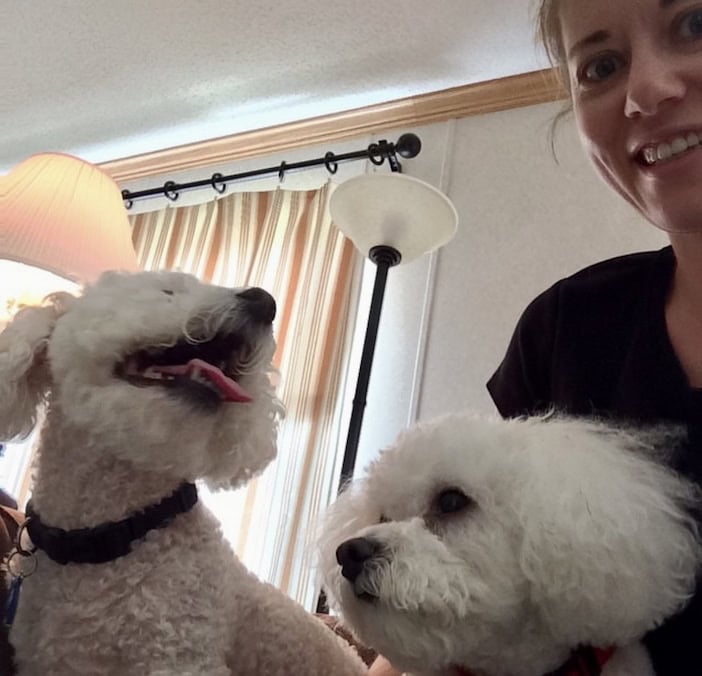
Regular Cleaning
The first step in managing tear stains is to clean your dog’s face regularly.
Use a soft, damp cloth or cotton ball to gently wipe away any tear residue.
This helps prevent the buildup of tear stains.
Eye Care
Check your dog’s eyes regularly for signs of irritation, redness, or excessive tearing.
If you notice any issues, call your vet and schedule a visit to address the underlying problem promptly.
Trimming Facial Hair
Keep the hair around your dog’s eyes trimmed to help reduce tear staining.
Longer facial hair tends to trap tears and moisture, which leads to more noticeable tear stains.
Filtered, Clean Water
Make sure your dog always has access to fresh, clean water.
Hydration is essential for overall health, and it can help dilute the tear fluid, which reduces the intensity of tear stains.
Also, try giving your dog filtered water!
Some dogs are sensitive to minerals and additives in tap water, which can contribute to tear staining.
Adjust Your Dog’s Diet
Tear stains can sometimes be linked to a dog’s diet because some foods can exacerbate tear staining.
This was the problem for Bichon Frisés Ralphie and Tori!
As I already mentioned earlier, common culprits include foods with artificial coloring, soy, wheat, or corn.
The dry dog food that Ralphie and Tori ate when they had noticeable tear stains was filled with them.
So their owners switched them to a much healthier, homemade dog food that consists of mixing healthy proteins with so-called base mixes.
You can read more about this type of homemade dog food here.
Also, if you suspect that your pup is sensitive to certain ingredients, try doing a dog sensitivity test with them.
I personally have had great success with the Glacier Peak Holistics Pet Wellness Life Stress Scan.
Granted, my pup Wally didn’t have any tear stains, but boy, was he itchy.
Turns out he can’t have any chicken, quail, salmon or grains!
Stainless Steel Or Ceramic Bowls
Along the lines of allergies, some dogs can also have allergies to certain materials used in their food and water bowls.
That said, try switching to stainless steel bowls to see if it helps reduce tear staining.
Avoid Face Rubbing
Last but not least, try to stop your dog from excessively rubbing or scratching their face because this can irritate the eye area more and spread tear stains.
Whenever you catch your dog starting to rub their face, redirect their attention to a favorite toy, treat, or a fun activity to break the habit.
You can also give them a gentle face and head massages to reduce the urge to rub their face.
When you can’t actively supervise them, you can have them wear a comfy cone for dogs.
It’s a much softer version of a rigid plastic e-cone.
Should I Take My Dog To The Vet For Tear Stains?
Sometimes, tear staining in dogs can be a symptom of an underlying medical condition, such as allergies or a tear duct blockage.
If the tear staining is persistent or accompanied by other concerning symptoms, I recommend you consult your veterinarian for a proper diagnosis and treatment plan.
They may recommend specific eye drops or medications to manage your pup’s tear production.
Specific eye drops helped my Husky client Haley after her owner took her in for a vet visit!
Best Product To Remove Tear Stains On Dogs
Coming up next, I’ll share a few products that worked for several of my dog walking clients and their white dogs.
However, please note that there’s no “one-size-fits-all” solution, and what works well for one dog may not work for another.
That said, you may have to try a few different options to find one that works for your pup.
Dog Tear Stain Wipes
Dog tear stain wipes are pre-moistened wipes specifically designed to gently clean the area around your dog’s eyes, removing tear stains.
Look for wipes that are free of harsh chemicals and fragrances to avoid irritation.
They worked well for my Goldendoodle client Lulu, pictured below!
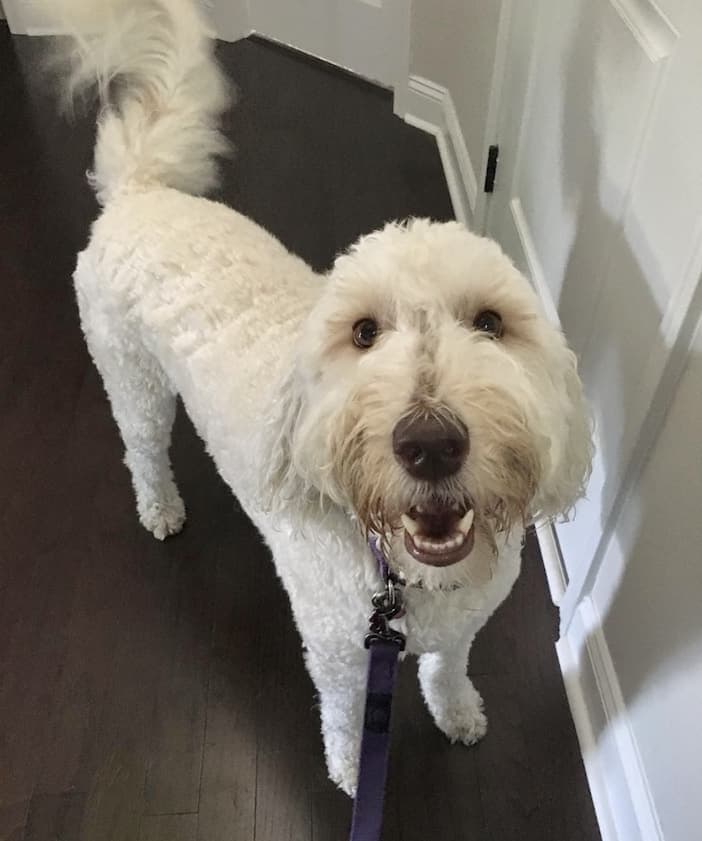
Tear Stain Remover Solutions
Tear stain remover solutions are liquid solutions you can apply to a cotton ball or soft cloth to wipe away tear stains on your dog.
They contain mild cleansers or natural ingredients like aloe vera to break down and remove the staining.
Tip: Avoid liquid tear stain removers with colloidal silver on the ingredient list as some dogs are allergic to silver.
It can also disrupt the natural balance of the dog’s skin microbiome.
Tear Stain Powders & Chews
Tear stain powders are usually sprinkled onto a dog’s food and come in different flavors:
These powders contain natural ingredients like cranberry, oregon grape root and marshmallow root.
The tear stain chews contain similar ingredients, but you obviously don’t need to mix them in with your dog’s food.
You can just offer them as treats.
Bottom Line
Granted, not all white dogs get tear stains.
But tear staining is more common in white-coated breeds or dogs with light-colored fur as it’s simply more noticeable on their light-colored coats.
Also, certain breeds are more susceptible to tear staining due to their physical characteristics.
For example, dogs with flat faces (brachycephalic breeds) like Shih Tzus, Bulldogs, and Pugs tend to be more prone to tear staining because their tear ducts are often shallow and can’t efficiently drain tears away from the eyes.
When you choose a tear stain removal product, consider the following:
- Safety: Look for products that are specifically formulated for dogs and are safe to use around their eyes. Avoid products with harsh chemicals, artificial ingredients and colloidal silver.
- Veterinary Guidance: Before using any tear stain removal supplement, it’s always a good idea to consult with your veterinarian, especially if your pup is on specific meds. That way, you avoid risking any unwanted interactions between the two products.
- Consistency: Tear stain removal often requires consistent and regular application of the chosen product. Be patient and follow the recommended usage instructions.
Remember that while tear stain removal products may help manage tear staining, they might not eliminate the problem entirely.
Also, what works for one dog might not work for another.
In some cases, tear staining can be related to an underlying medical issue, so addressing the root cause is essential for effective management!
Save To Pinterest
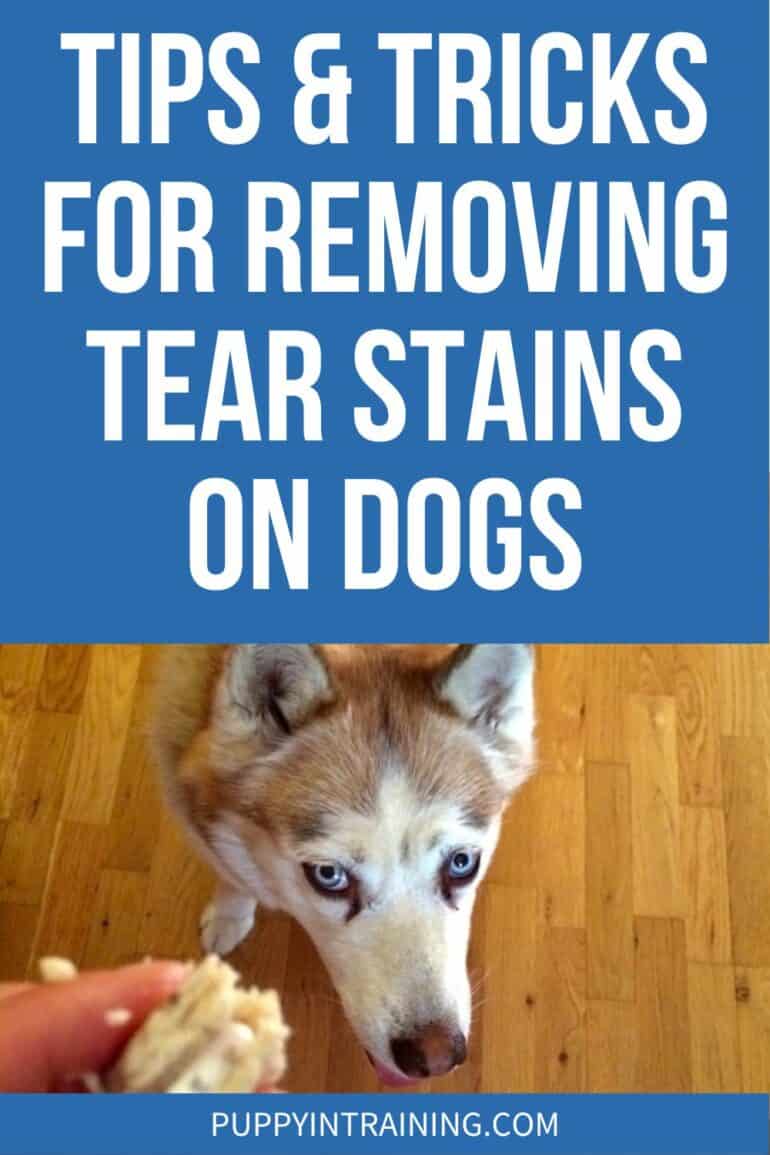
Top Picks For Our Puppies
- BEST PUPPY TOY
We Like: Calmeroos Puppy Toy w/ Heartbeat and Heat Packs – Perfect for new puppies. Helps ease anxiety in their new home. - BEST DOG CHEW
We Like: Mighty Paw Naturals Bully Sticks – All of our puppies love to bite, nip, and chew. We love using Bully Sticks to help divert these unwanted behaviors. - BEST DOG TREATS
We Like: Crazy Dog Train-Me Treats – We use these as our high-value treats for our guide dog puppies. - BEST FRESH DOG FOOD
We Like: The Farmer’s Dog – A couple months ago we started feeding Raven fresh dog food and she loves it! Get 50% off your first order of The Farmer’s Dog.
Check out more of our favorites on our New Puppy Checklist.

